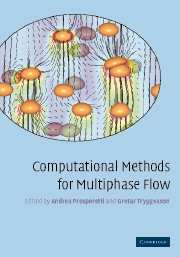Book contents
- Frontmatter
- Contents
- Preface
- Acknowledgments
- 1 Introduction: A computational approach to multiphase flow
- 2 Direct numerical simulations of finite Reynolds number flows
- 3 Immersed boundary methods for fluid interfaces
- 4 Structured grid methods for solid particles
- 5 Finite element methods for particulate flows
- 6 Lattice Boltzmann models for multiphase flows
- 7 Boundary integral methods for Stokes flows
- 8 Averaged equations for multiphase flow
- 9 Point-particle methods for disperse flows
- 10 Segregated methods for two-fluid models
- 11 Coupled methods for multifluid models
- References
- Index
3 - Immersed boundary methods for fluid interfaces
Published online by Cambridge University Press: 07 December 2009
- Frontmatter
- Contents
- Preface
- Acknowledgments
- 1 Introduction: A computational approach to multiphase flow
- 2 Direct numerical simulations of finite Reynolds number flows
- 3 Immersed boundary methods for fluid interfaces
- 4 Structured grid methods for solid particles
- 5 Finite element methods for particulate flows
- 6 Lattice Boltzmann models for multiphase flows
- 7 Boundary integral methods for Stokes flows
- 8 Averaged equations for multiphase flow
- 9 Point-particle methods for disperse flows
- 10 Segregated methods for two-fluid models
- 11 Coupled methods for multifluid models
- References
- Index
Summary
Nearly half a century of computational fluid dynamics has shown that it is very hard to beat uniform structured grids in terms of ease of implementation and computational efficiency. It is therefore not surprising that a large fraction of the most popular methods for finite Reynolds number multiphase flows today are methods where the governing equations are solved on such grids. The possibility of writing one set of governing equations for the whole flow field, frequently referred to as the “one-fluid” formulation, has been known since the beginning of large-scale computational studies of multiphase flows. It was, in particular, used by researchers at the Los Alamos National Laboratory in the early 1960s for the marker-and-cell (MAC) method, which permitted the first successful simulation of the finite Reynolds number motion of free surfaces and fluid interfaces. This approach was based on using marker particles distributed uniformly in each fluid to identify the different fluids. The material properties were reconstructed from the marker particles and sometimes separate surface markers were also introduced to facilitate the computation of the surface tension. While the historical importance of the MAC method for multiphase flow simulations cannot be overstated, it is now obsolete. In current usage, the term “MAC method” usually refers to a projection method using a staggered grid.
When the governing equations are solved on a fixed grid, the different fluids must be identified by a marker function that is advected by the flow. Several methods have been developed for that purpose. The volume-of-fluid (VOF) method is the oldest and, after many improvements and innovations, continues to be widely used. Other marker function methods include the level-set method, the phase-field method, and the constrained interpolated propagation (CIP) method.
- Type
- Chapter
- Information
- Computational Methods for Multiphase Flow , pp. 37 - 77Publisher: Cambridge University PressPrint publication year: 2007
- 20
- Cited by

